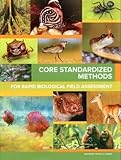Core standardized methods for rapid biological field assessment / edited by Trond H. Larsen
Larsen, Trond H [editor].
Tipo de material: Libro
impreso(a)
y electrónico
Editor: Arlington, Virginia, United States: Conservation International, c2016Descripción: 207 páginas : fotografías, ilustraciones, retratos ; 28 centímetros.ISBN: 1934151963; 9781934151969.Tema(s): Evaluación ecológica (Biología)
Libro
impreso(a)
y electrónico
Editor: Arlington, Virginia, United States: Conservation International, c2016Descripción: 207 páginas : fotografías, ilustraciones, retratos ; 28 centímetros.ISBN: 1934151963; 9781934151969.Tema(s): Evaluación ecológica (Biología)| Tipo de ítem | Biblioteca actual | Colección | Signatura | Estado | Fecha de vencimiento | Código de barras |
|---|---|---|---|---|---|---|
| Libros | Biblioteca Electrónica Recursos en línea (RE) | Acervo General | Recurso digital | ECO400580614479 | ||
| Libros |
Biblioteca Tapachula
Texto colocado en la configuración de la biblioteca Tapachula |
Acervo General | 577.0287 C6 | Disponible | ECO020013580 |
Incluye bibliografía
Introduction.. Vascular Plants (non-Epiphytes.. Vascular Epiphytes.. Medium and Large-sized Mammals.. Camera traps.. Bats.. Small non-Volant Mammals.. Birds.. Herpetofauna.. Freshwater Fishes.. Fruit-Feeding butterflies.. Dung beetles.. Leaf Litter ants.. Freshwater Molluscs
Acceso en línea sin restricciones
Reliable, standardized and replicable methodologies for quickly assessing key ecosystem values in the field are essential for conservation planning and decision-making at the local to regional scale at which most threats occur. Rapid biological assessments are a cost-effective solution to this problem, providing data in a timely manner to address a wide range of conservation needs, and in particular to establish a baseline that can be used to detect changes over time. A great deal of high level methodological guidance exists, but most lack practical detail. A few books describe relatively comprehensive sampling methods but do not focus on a core set of standardized methods, making it difficult to decide which protocols to adopt. Other publications are available with lengthy, detailed guidance on sampling individual taxa. The editor believes this is the first book that focuses exclusively on a concise, practical set of standardized protocols for a wide range of taxa. This is no simple task. Many scientists tend to employ their own individualized, often opportunistic, approachesfor finding as many species as possible in a short time, sometimes honed through decades of personal experience. These contributions are invaluable, yet do not address many conservation requirements. While not intended to replace these methods, the identification of a core, at-a-minimum set of standardized methods, including innovative and automated approaches where applicable, is of great importance for making the results of rapid surveys comparable and replicable across sites and over time. Typically, rapid assessments require at least one week per site. A critical and often unanswered question in baseline assessments is how to know when sampling effort is sufficient. We have addressed this question with representative species accumulation curves and analyses in each individual chapter. eng
The focus of this book is on tropical terrestrial and freshwater ecosystems worldwide, although most methods should be applicable in temperate zones as well. It is not possible to sample all taxonomic groups during a rapid survey. In this book, we describe methods for major taxonomic groups (plants, vertebrates), as well as a select set of invertebrates that represent cost-effective indicator taxa and play important ecological roles. This book represents a consensus of multiple experts for each taxonomic group, including intensive peer review. It is expected that a future edition of this book will include methods for marine taxa, various ecosystem services, as well as social assessments. A separate chapter on analytical approaches or data management is not included, as these are already well covered in other publications. eng
Disponible en línea
Adobe Acrobat profesional 6.0 o superior
